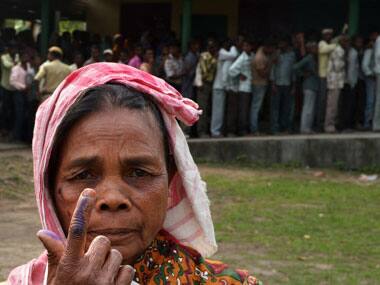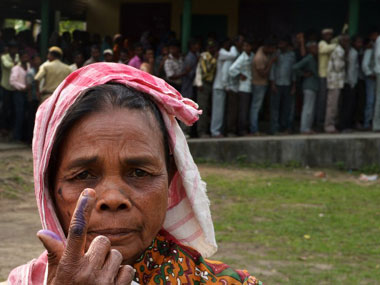[caption id=“attachment_1501773” align=“alignleft” width=“380”]
 Representational image. AFP[/caption] This is a snapshot of all the opinion polls conducted on the Lok Sabha elections in 2014. The sample ranges from a low of 14,000 to a high of 46471. These are the opinion polls that form the backbone of the media chatter on a Modi sweep across the country.
Representational image. AFP[/caption] This is a snapshot of all the opinion polls conducted on the Lok Sabha elections in 2014. The sample ranges from a low of 14,000 to a high of 46471. These are the opinion polls that form the backbone of the media chatter on a Modi sweep across the country.
 Each poll claims to be reliable and accurate, but, when seen together, it is apparent that all cannot be so. For example, if the ABP News-Nielsen February projection of 92 seats for the UPA is correct, all the others are horribly off the mark. Similarly, if the NDTV-Hansa Research projection of 275 seats is correct, the rest of the polls come a cropper. That’s not quite correct. The results of the polls reflect the mood of the respondents during the time the poll was conducted – and this changes from time to time. So when NDTV-Hansa gives the UPA 128 seats in March and then 111 seats in April, this is completely possible. The important point to note that the earlier a poll was conducted, the less relevance the poll has today — yet all the polls are bandied about as gospel. Take, for example, the polls for Punjab. Polls conducted in January-February 2014, March 2014 and April 2014 give the Congress 6, 8 and 6 seats respectively. For Uttar Pradesh, various polls conducted in 2014 give the Congress anything between 4 and 12 seats. Polls for West Bengal conducted this year give the Congress anywhere between 1 and 10 seats! Presuming all the polls to be honest (
some
have been proven not to be so), the variation in the figures would mean that changes in the environment cause changes in the voter behaviour and choice. Which is why all these opinion polls are irrelevant now. Consider the situation when the last poll was conducted: *All the pre-poll alliances were not in place *We had no idea how many seats AAP would contest *We had no idea whether the voter turnout would increase or decrease *We did not know the contenders in key constituencies *We had little idea of how many direct battles would be fought and how many multi-cornered contests would be fought *We did not know the impact of None of The Above (NOTA) All these are variables that could change voter perception and, therefore outcome. For example, the AAP has fielded over 400 candidates, a number that has caught many by surprise. For every seat where the AAP fields a candidate, the voter has a new option and the equation will change. Does any one of these polls factor the AAP impact? What the AAP wins could have considerable impact. In the 2009 elections, in UP, 34 of the 80 constituencies saw margins of less than 35,000. Of these, 6 saw margins under 10,000, 4 saw margins between 10,000 and 15,000, 7 saw margins between 25,000 and 30,000 and another 5 saw margins between 30,000 and 35,000. Uttar Pradesh figures are used just as an illustration of what could happen. Remember, most constituencies in UP have more than 15,00,000 eligible voters. Now, with the wisdom of hindsight, we now know that AAP will be seen in action in over 400 seats; we know that the voter turnout has been the highest ever, we know that the number of multi-cornered elections is high. We still do not know the impact of NOTA. What we are likely to see is lower winning margins — and even the AAP winning a small number and another small number opting for NOTA could skew results way out of kilter. So what do we learn? That none of the opinion polls held holds any relevance. And that the only thing predictable about the 2014 elections is the unpredictability.
Each poll claims to be reliable and accurate, but, when seen together, it is apparent that all cannot be so. For example, if the ABP News-Nielsen February projection of 92 seats for the UPA is correct, all the others are horribly off the mark. Similarly, if the NDTV-Hansa Research projection of 275 seats is correct, the rest of the polls come a cropper. That’s not quite correct. The results of the polls reflect the mood of the respondents during the time the poll was conducted – and this changes from time to time. So when NDTV-Hansa gives the UPA 128 seats in March and then 111 seats in April, this is completely possible. The important point to note that the earlier a poll was conducted, the less relevance the poll has today — yet all the polls are bandied about as gospel. Take, for example, the polls for Punjab. Polls conducted in January-February 2014, March 2014 and April 2014 give the Congress 6, 8 and 6 seats respectively. For Uttar Pradesh, various polls conducted in 2014 give the Congress anything between 4 and 12 seats. Polls for West Bengal conducted this year give the Congress anywhere between 1 and 10 seats! Presuming all the polls to be honest (
some
have been proven not to be so), the variation in the figures would mean that changes in the environment cause changes in the voter behaviour and choice. Which is why all these opinion polls are irrelevant now. Consider the situation when the last poll was conducted: *All the pre-poll alliances were not in place *We had no idea how many seats AAP would contest *We had no idea whether the voter turnout would increase or decrease *We did not know the contenders in key constituencies *We had little idea of how many direct battles would be fought and how many multi-cornered contests would be fought *We did not know the impact of None of The Above (NOTA) All these are variables that could change voter perception and, therefore outcome. For example, the AAP has fielded over 400 candidates, a number that has caught many by surprise. For every seat where the AAP fields a candidate, the voter has a new option and the equation will change. Does any one of these polls factor the AAP impact? What the AAP wins could have considerable impact. In the 2009 elections, in UP, 34 of the 80 constituencies saw margins of less than 35,000. Of these, 6 saw margins under 10,000, 4 saw margins between 10,000 and 15,000, 7 saw margins between 25,000 and 30,000 and another 5 saw margins between 30,000 and 35,000. Uttar Pradesh figures are used just as an illustration of what could happen. Remember, most constituencies in UP have more than 15,00,000 eligible voters. Now, with the wisdom of hindsight, we now know that AAP will be seen in action in over 400 seats; we know that the voter turnout has been the highest ever, we know that the number of multi-cornered elections is high. We still do not know the impact of NOTA. What we are likely to see is lower winning margins — and even the AAP winning a small number and another small number opting for NOTA could skew results way out of kilter. So what do we learn? That none of the opinion polls held holds any relevance. And that the only thing predictable about the 2014 elections is the unpredictability.
Anant Rangaswami was, until recently, the editor of Campaign India magazine, of which Anant was also the founding editor. Campaign India is now arguably India's most respected publication in the advertising and media space. Anant has over 20 years experience in media and advertising. He began in Madras, for STAR TV, moving on as Regional Manager, South for Sony’s SET and finally as Chief Manager at BCCL’s Times Television and Times FM. He then moved to advertising, rising to the post of Associate Vice President at TBWA India. Anant then made the leap into journalism, taking over as editor of what is now Campaign India's competitive publication, Impact. Anant teaches regularly and is a prolific blogger and author of Watching from the sidelines.
)